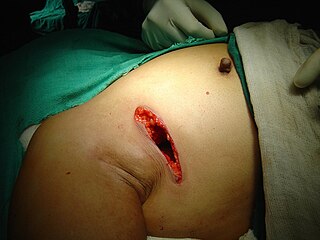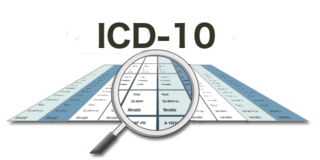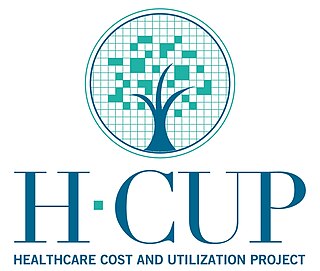See also
 ICD-10-PCS (P1690) (see uses )
ICD-10-PCS (P1690) (see uses )
The ICD-10 Procedure Coding System (ICD-10-PCS) is a US system of medical classification used for procedural coding. The Centers for Medicare and Medicaid Services, the agency responsible for maintaining the inpatient procedure code set in the U.S., contracted with 3M Health Information Systems in 1995 to design and then develop a procedure classification system to replace Volume 3 of ICD-9-CM. ICD-9-CM contains a procedure classification; ICD-10-CM does not. ICD-10-PCS is the result. ICD-10-PCS was initially released in 1998. It has been updated annually since that time. [1] Despite being named after the WHO's International Classification of Diseases, it is a US-developed standard which is not used outside the United States. [2]
Each code consists of seven alphanumeric characters. The first character is the 'section'. The second through seventh characters mean different things in each section. Each character can be any of 34 possible values the ten digits 0-9 and the 24 letters A-H, J-N and P-Z may be used in each character. The letters O and I are excluded to avoid confusion with the numbers 0 and 1. [3] There are no decimals in ICD-10-PCS [4]
Of the 72,081 codes in ICD-10-PCS, 62,022 are in the first section, "Medical and surgical". [5]
| Character 1 | Character 2 | Character 3 | Character 4 | Character 5 | Character 6 | Character 7 |
|---|---|---|---|---|---|---|
| 0 Medical and Surgical | Body System 0 Central nervous system; 1 Peripheral nervous system; 2 Heart and Great vessels; 3 Upper arteries; 4 Lower arteries; 5 Upper veins; 6 Lower veins; 7 Lymphatic and Hemic system; 8 Eye; 9 Ear, Nose, Sinus; B Respiratory System; C Mouth and Throat; D Gastrointestinal system; F Hepatobiliary System and Pancreas; G Endocrine system; H Skin and Breast; J Subcutaneous tissue; K Muscles; L Tendons; M Bursae and Ligaments; N Head and Facial bones; P Upper bones; Q Lower bones; R Upper joints; S Lower joints; T Urinary system; U Female reproductive system; V Male reproductive system; W Anatomical regions, General; X Anatomical regions, Upper extremities; Y Anatomical regions, Lower extremities | Root Operation see below | Body Part | Approach 0 Open; 3 Percutaneous; 4 Percutaneous Endoscopic; 7 Via Natural or Artificial Opening; 8 Via Natural or Artificial Opening Endoscopic; F Via Natural or Artificial Opening Endoscopic with Percutaneous Endoscopic Assistance; X External | Device | Qualifier |
| 1 Obstetrics | 10 Pregnancy | 102 Change; 109 Drainage; 10A Abortion; 10D Extraction; 10E Delivery; 10H Insertion; 10J Inspection; 10P Removal; 10Q Repair; 10S Reposition; 10T Resection; 10Y Transplantation | Body Part | Approach | Device | Qualifier |
| 2 Placement | 2W Anatomical Regions; 2Y Anatomical Orifices | Root Operation 2?0 Change; 2?1 Compression; 2?2 Dressing; 2?3 Immobilization; 2?4 Packing; 2?5 Removal; 2?6 Traction | Body Region/Orifice | Approach | Device | Qualifier |
| 3 Administration | 30 Circulatory; 3CIndwelling Device; 3E Physiological Systems and Anatomical Regions | Root Operation | Body System/Region | Approach | Substance | Qualifier |
| 4 Measurement and Monitoring | 4A Physiological Systems; 4B Physiological Devices | Root Operation | Body System | Approach | Function | Qualifier |
| 5 Extracorporeal Assistance and Performance | 5A Physiological Systems | Root Operation | Body System | Duration | Function | Qualifier |
| 6 Extracorporeal Therapies | 6A Physiological Systems | Root Operation 6A0 Atmospheric control; 6A1 Decompression; 6A2 Electromagnetic therapy; 6A3 Hyperthermia; 6A4 Hypothermia; 6A5 Pheresis; 6A6 Phototherapy; 6A7 Ultrasound therapy; 6A8 Ultraviolet light therapy; 6A9 Shock wave therapy | Body System | Duration | Qualifier | Qualifier |
| 7 Osteopathic | 7W | 7W0 | Body Region | Approach | Method | Qualifier |
| 8 Other Procedures | 8C Indwelling Device; 8E Physiological Systems and Anatomical Regions | Root Operation | Body Region | Approach | Method | Qualifier |
| 9 Chiropractic | 9W | 9WB | Body Region | Approach | Method | Qualifier |
| B Imaging | Body System 0 Central Nervous System; 2 Heart; 3 Upper Arteries; 4 Lower Arteries; 5 Veins; 7 Lymphatic System; 8 Eye; 9 Ear, Nose, Mouth and Throat; B Respiratory System; D Gastrointestinal System; F Hepatobiliary System and Pancreas; G Endocrine System; H Skin, Subcutaneous Tissue and Breast; L Connective Tissue; N Skull and Facial Bones; P Non-Axial Upper Bones; Q Non-Axial Lower Bones; R Axial Skeleton, Except Skull and Facial Bones; T Urinary System; U Female Reproductive System; V Male Reproductive System; W Anatomical Regions; Y Fetus and Obstetrical | Root Type | Body Part | Contrast 0=high osmolar contrast; 1=low osmolar contrast; z=other contrast | Qualifier | Qualifier |
| C Nuclear medicine | Body System 0 Central Nervous System; 2 Heart; 5 Veins; 7 Lymphatic and Hematologic System; 8 Eye; 9 Ear, Nose, Mouth and Throat; B Respiratory System; D Gastrointestinal System; F Hepatobiliary System and Pancreas; G Endocrine System; H Skin, Subcutaneous Tissue and Breast; P Musculoskeletal System; T Urinary System; V Male Reproductive System; W Anatomical Regions | Root Type | Body Part | Radionuclide | Qualifier | Qualifier |
| D Radiation oncology | Body System 0 Central and Peripheral Nervous System; 7 Lymphatic and Hematologic System; 8 Eye; 9 Ear, Nose, Mouth and Throat; B Respiratory System; D Gastrointestinal System; F Hepatobiliary System and Pancreas; G Endocrine System; H Skin; M Breast; P Musculoskeletal System; T Urinary System; U Female Reproductive System; V Male Reproductive System; W Anatomical Regions | Root Type | Body Part | Modality Qualifier | Isotope | Qualifier |
| F Physical rehabilitation and Diagnostic Audiology | F/0 Rehabilitation; F/1 Diagnostic Audiology | Root Type | Body System & Region | Type Qualifier | Equipment | Qualifier |
| G Mental health | GZ None | Root Type GZ1 Psychological tests; GZ2 Crisis intervention; GZ3 Medication management; GZ5 Individual psychotherapy; GZ6 Counseling; GZ7 Family psychotherapy; GZB Electroconvulsive therapy; GZC Biofeedback; GZF Hypnosis; GZG Narcosynthesis; GZH Group psychotherapy; GZJ Light therapy | Type Qualifier | Qualifier | Qualifier | Qualifier |
| H Substance abuse Treatment | HZ None | Root Type | Type Qualifier | Qualifier | Qualifier | Qualifier |
| X New Technology |
For medical/surgical, these are the root operation codes:
00 alteration; 01 bypass; 02 change; 03 control; 04 creation; 05 destruction; 06 detachment; 07 dilation; 08 division; 09 drainage; 0B excision; 0C extirpation; 0D extraction; 0F fragmentation; 0G fusion; 0H insertion; 0J inspection; 0K map; 0L occlusion; 0M reattachment; 0N release; 0P removal; 0Q repair; 0R replacement; 0S reposition; 0T resection; 0U supplement ; 0V restriction; 0W revision; 0X transfer; 0Y transplantation
They can be grouped into several categories: [5]
| Region | Code |
|---|---|
| Head | 0 |
| Cervical | 1 |
| Thoracic | 2 |
| Lumbar | 3 |
| Sacrum | 4 |
| Pelvis | 5 |
| Lower extremities | 6 |
| Upper extremities | 7 |
| Rib cage | 8 |
| Abdomen | 9 |

Gastroenterology is the branch of medicine focused on the digestive system and its disorders. The digestive system consists of the gastrointestinal tract, sometimes referred to as the GI tract, which includes the esophagus, stomach, small intestine and large intestine as well as the accessory organs of digestion which include the pancreas, gallbladder, and liver.
The International Classification of Diseases (ICD) is a globally used medical classification used in epidemiology, health management and for clinical purposes. The ICD is maintained by the World Health Organization (WHO), which is the directing and coordinating authority for health within the United Nations System. The ICD is originally designed as a health care classification system, providing a system of diagnostic codes for classifying diseases, including nuanced classifications of a wide variety of signs, symptoms, abnormal findings, complaints, social circumstances, and external causes of injury or disease. This system is designed to map health conditions to corresponding generic categories together with specific variations, assigning for these a designated code, up to six characters long. Thus, major categories are designed to include a set of similar diseases.

Surgery is a medical specialty that uses manual and instrumental techniques to diagnose or treat pathological conditions, to alter bodily functions, to reconstruct or improve aesthetics and appearance, or to remove unwanted tissues or foreign bodies. The subject receiving the surgery is typically a person, but can also be a non-human animal.
Diagnosis-related group (DRG) is a system to classify hospital cases into one of originally 467 groups, with the last group being "Ungroupable". This system of classification was developed as a collaborative project by Robert B Fetter, PhD, of the Yale School of Management, and John D. Thompson, MPH, of the Yale School of Public Health. The system is also referred to as "the DRGs", and its intent was to identify the "products" that a hospital provides. One example of a "product" is an appendectomy. The system was developed in anticipation of convincing Congress to use it for reimbursement, to replace "cost based" reimbursement that had been used up to that point. DRGs are assigned by a "grouper" program based on ICD diagnoses, procedures, age, sex, discharge status, and the presence of complications or comorbidities. DRGs have been used in the US since 1982 to determine how much Medicare pays the hospital for each "product", since patients within each category are clinically similar and are expected to use the same level of hospital resources. DRGs may be further grouped into Major Diagnostic Categories (MDCs). DRGs are also standard practice for establishing reimbursements for other Medicare related reimbursements such as to home healthcare providers.
The Major Diagnostic Categories (MDC) are formed by dividing all possible principal diagnoses into 25 mutually exclusive diagnosis areas. MDC codes, like diagnosis-related group (DRG) codes, are primarily a claims and administrative data element unique to the United States medical care reimbursement system. DRG codes also are mapped, or grouped, into MDC codes.

A biopsy is a medical test commonly performed by a surgeon, an interventional radiologist, or an interventional cardiologist. The process involves the extraction of sample cells or tissues for examination to determine the presence or extent of a disease. The tissue is then fixed, dehydrated, embedded, sectioned, stained and mounted before it is generally examined under a microscope by a pathologist; it may also be analyzed chemically. When an entire lump or suspicious area is removed, the procedure is called an excisional biopsy. An incisional biopsy or core biopsy samples a portion of the abnormal tissue without attempting to remove the entire lesion or tumor. When a sample of tissue or fluid is removed with a needle in such a way that cells are removed without preserving the histological architecture of the tissue cells, the procedure is called a needle aspiration biopsy. Biopsies are most commonly performed for insight into possible cancerous or inflammatory conditions.

Eye surgery, also known as ophthalmic surgery or ocular surgery, is surgery performed on the eye or its adnexa. Eye surgery is part of ophthalmology and is performed by an ophthalmologist or eye surgeon. The eye is a fragile organ, and requires due care before, during, and after a surgical procedure to minimize or prevent further damage. An eye surgeon is responsible for selecting the appropriate surgical procedure for the patient, and for taking the necessary safety precautions. Mentions of eye surgery can be found in several ancient texts dating back as early as 1800 BC, with cataract treatment starting in the fifth century BC. It continues to be a widely practiced class of surgery, with various techniques having been developed for treating eye problems.
A medical classification is used to transform descriptions of medical diagnoses or procedures into standardized statistical code in a process known as clinical coding. Diagnosis classifications list diagnosis codes, which are used to track diseases and other health conditions, inclusive of chronic diseases such as diabetes mellitus and heart disease, and infectious diseases such as norovirus, the flu, and athlete's foot. Procedure classifications list procedure code, which are used to capture interventional data. These diagnosis and procedure codes are used by health care providers, government health programs, private health insurance companies, workers' compensation carriers, software developers, and others for a variety of applications in medicine, public health and medical informatics, including:

Dermatofibrosarcoma protuberans (DFSP) is a rare locally aggressive malignant cutaneous soft-tissue sarcoma. DFSP develops in the connective tissue cells in the middle layer of the skin (dermis). Estimates of the overall occurrence of DFSP in the United States are 0.8 to 4.5 cases per million persons per year. In the United States, DFSP accounts for between 1 and 6 percent of all soft-tissue sarcomas and 18 percent of all cutaneous soft-tissue sarcomas. In the Surveillance, Epidemiology and End Results (SEER) tumor registry from 1992 through 2004, DFSP was second only to Kaposi sarcoma.

Lumpectomy is a surgical removal of a discrete portion or "lump" of breast tissue, usually in the treatment of a malignant tumor or breast cancer. It is considered a viable breast conservation therapy, as the amount of tissue removed is limited compared to a full-breast mastectomy, and thus may have physical and emotional advantages over more disfiguring treatment. Sometimes a lumpectomy may be used to either confirm or rule out that cancer has actually been detected. A lumpectomy is usually recommended to patients whose cancer has been detected early and who do not have enlarged tumors. Although a lumpectomy is used to allow for most of the breast to remain intact, the procedure may result in adverse affects that can include sensitivity and result in scar tissue, pain, and possible disfiguration of the breast if the lump taken out is significant. According to National Comprehensive Cancer Network guidelines, lumpectomy may be performed for ductal carcinoma in situ (DCIS), invasive ductal carcinoma, or other conditions.
The Current Procedural Terminology (CPT) code set is a procedural code set developed by the American Medical Association (AMA). It is maintained by the CPT Editorial Panel. The CPT code set describes medical, surgical, and diagnostic services and is designed to communicate uniform information about medical services and procedures among physicians, coders, patients, accreditation organizations, and payers for administrative, financial, and analytical purposes. New editions are released each October, with CPT 2021 being in use since October 2021. It is available in both a standard edition and a professional edition.
ICD-9-CM Volume 3 is a system of procedural codes used by health insurers to classify medical procedures for billing purposes. It is a subset of the International Statistical Classification of Diseases and Related Health Problems (ICD) 9-CM. Volumes 1 and 2 are used for diagnostic codes.
The International Classification of Health Interventions (ICHI) is a system of classifying procedure codes being developed by the World Health Organization (WHO). It is currently available as a beta 3 release. The components for clinical documentation are stable. The component on public health interventions is in the process of being finalized. Updates on development and status of the classification are listed on WHO home page.

ICD-10 is the 10th revision of the International Statistical Classification of Diseases and Related Health Problems (ICD), a medical classification list by the World Health Organization (WHO). It contains codes for diseases, signs and symptoms, abnormal findings, complaints, social circumstances, and external causes of injury or diseases. Work on ICD-10 began in 1983, became endorsed by the Forty-third World Health Assembly in 1990, and was first used by member states in 1994. It was replaced by ICD-11 on January 1, 2022.

The Healthcare Cost and Utilization Project is a family of healthcare databases and related software tools and products from the United States that is developed through a Federal-State-Industry partnership and sponsored by the Agency for Healthcare Research and Quality (AHRQ).
A hospital-acquired condition (HAC) is an undesirable situation or condition that affects a patient and that arose during a stay in a hospital or medical facility. It is a designation used by Medicare/Medicaid in the US for determining MS-DRG reimbursement beginning with version 26. Not only hospital-acquired infections but also any other situation or condition, such as pressure ulcers, blood type mismatch, or iatrogenic injury, can be a HAC.
OPS, the Operationen- und Prozedurenschlüssel is the German modification of the International Classification of Procedures in Medicine (ICPM). For German hospitals it is currently the official coding system for medical procedures. Apart from its use for clinical controlling and performance statistics it is a basis for inpatient claims processing within the German Diagnosis-related Groups (G-DRG) system. Yearly OPS releases are produced by DIMDI. Besides OPS, G-DRG also requires disease codes based on ICD-10-GM is.

Renal ultrasonography is the examination of one or both kidneys using medical ultrasound.
The ICD-10 Clinical Modification (ICD-10-CM) is a set of diagnosis codes used in the United States of America. It was developed by a component of the U.S. Department of Health and Human services, as an adaption of the ICD-10 with authorization from the World Health Organization. In 2015, ICD-10-CM replaced ICD-9-CM as the federally mandated classification. Annual updates are provided.